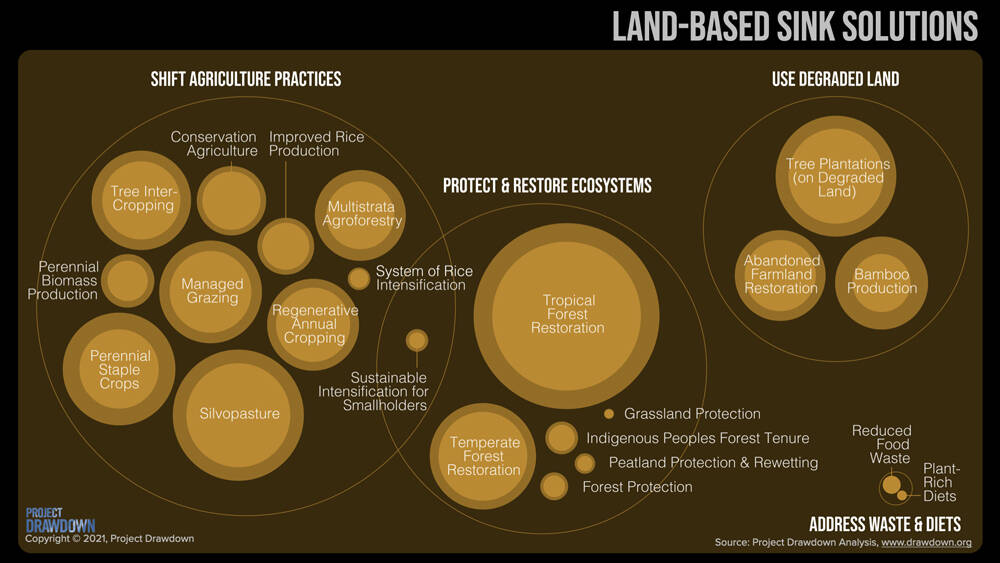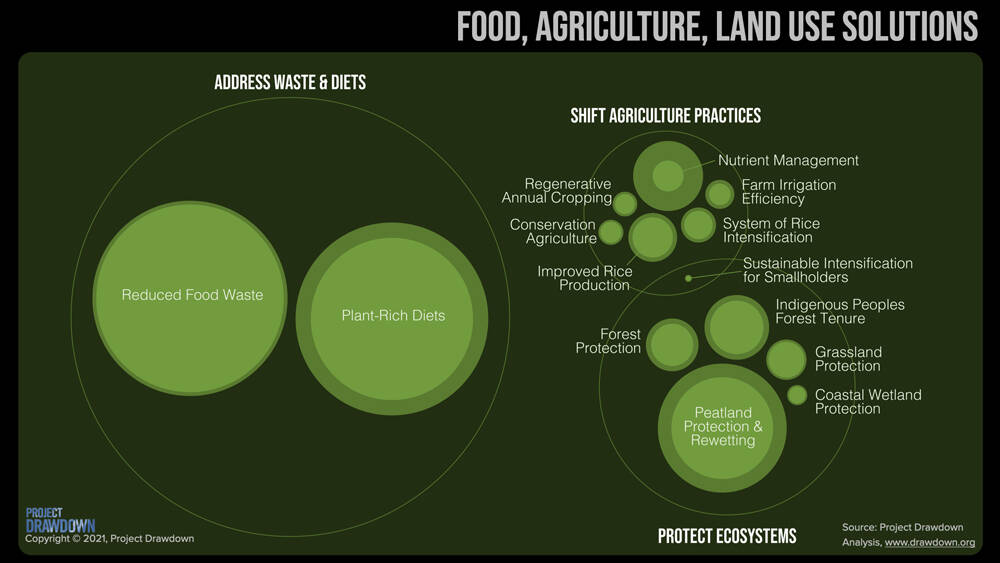
Reduce food waste
Reducing waste is the most impactful solution available, and needs to happen at every point of the value chain.Shift towards plant rich diets
Animal products have a much higher impact than plant based alternatives. Reducing our reliance on animals by shifting to a plant forward diet would have an enormous impact.Shifting agricultural practices
This includes things like nutrient management to make sure we don’t use any more than we need. The kind of shifts that are needed really depend on where you are in the world.
Top 3 climate solutions for food producers
“There’s a couple of different directions we could go in. Climate solutions 102 might be a deeper dive into different solution clusters. We might look at food, agriculture and land use and go much deeper than the cursory look we took in 101. We want to present these solutions visually, in a way that drives people to actions they can take in their own community. If we level up a little more and move to climate solutions 201, we are kind of moving from giving people the ingredients for a dish, to providing them with the recipe. We need to get into the kitchen and start cooking and baking alongside people so that the climate solution ingredients can turn into a dish that’s greater than the sum of its parts. We would go deeper into things like goals. What’s the difference between net zero and carbon negative, and why do we care? We would look at timeframes, like what would the different waves of climate action look like for all the different sectors? And how would we scale? All these solutions are like pieces on a chess board. How do we win this game of chess?”
What would climate solutions 102 look like?

What’s Drawdown Learn doing to help food professionals tackle the challenges they’re facing?
“One of our next steps is going to focus on storytelling. People need to see these solutions in action. Not everyone can relate to the raw numbers and hard science. We want to connect with the people making these things happen. We’re going to do a deep dive into communities here in the US, listening to underserved and minority voices. Talking to not just executive directors but to the people on the ground implementing these solutions. I could tell you all day long about the impactful climate solutions we’ve looked at, but until you can put a face to them, until there are people in your neighborhood actually willing to step up, those are just words on a page. We don’t need more of those right now. The younger generation is rightfully angry at the state of climate solutions. They want their jobs to be meaningful, want to contribute to solving the problem. Every job is a climate job now.”
“We made a video series called Climate Solutions 101, in which we try to shift the narrative from the challenges towards the solutions. The series wasn’t initially aimed at food professionals, but it has resonated with people all over the world. For anyone wanting to build a solid foundation on climate solutions, the series is a great first step.
Staying focused on solutions becomes easier when you have a framework to put them in. Our framework consists of the ‘three S’es’ of reducing heat trapping gasses: reduce Sources, support Sinks, and improve Society. Just having that framework helps people make sense of what seems like an incomprehensible problem.”

What’s the first thing food producers need to know about how to solve the climate crisis?
“Reducing food waste. We need to be much more thoughtful and efficient about how food is produced to eliminate waste. There’s more wasted than just food. It’s land, labor, fertilizer, and all of those come with their greenhouse gas emissions. The way to tackle food waste really depends on where you are in the value chain. You can look at what for example ReFed is doing, or the work being done together with indiginous farmers to deindustrialize agriculture. There aren’t any fancy or flashy solutions, but we don’t need those. We have all the solutions we need to reach Drawdown, the point at which the amount of heat trapping gasses in our atmosphere begins to decrease. Some of the solutions for the food system are ancient techniques like silvopasture, which is something we abandoned because it couldn’t be efficiently industrialized.”
Elizabeth Bagley wants to focus on climate solutions, instead of climate problems
The solutions aren’t fancy or flashy, but they can solve the climate crisis
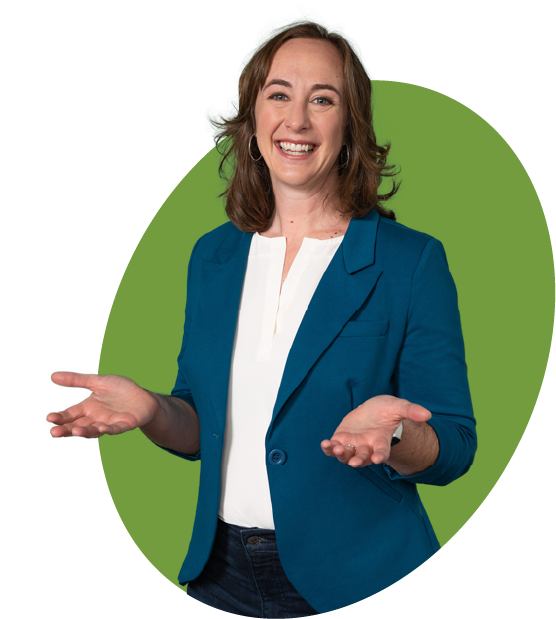
Elizabeth Bagley is the Director of Drawdown Learn at Project Drawdown. Food Inspiration spoke with her about focusing on climate solutions instead of climate problems, and the role food producers can and need to play to realize a livable future.
Jelle Steenbergen Xiao Er Kong
interview
28 min



Reduce food waste
Reducing waste is the most impactful solution available, and needs to happen at every point of the value chain.Shift towards plant rich diets
Animal products have a much higher impact than plant based alternatives. Reducing our reliance on animals by shifting to a plant forward diet would have an enormous impact.Shifting agricultural practices
This includes things like nutrient management to make sure we don’t use any more than we need. The kind of shifts that are needed really depend on where you are in the world.
Top 3 climate solutions for food producers
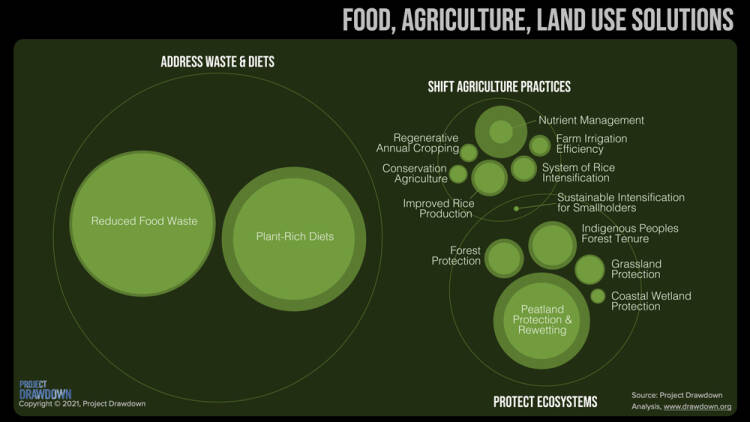
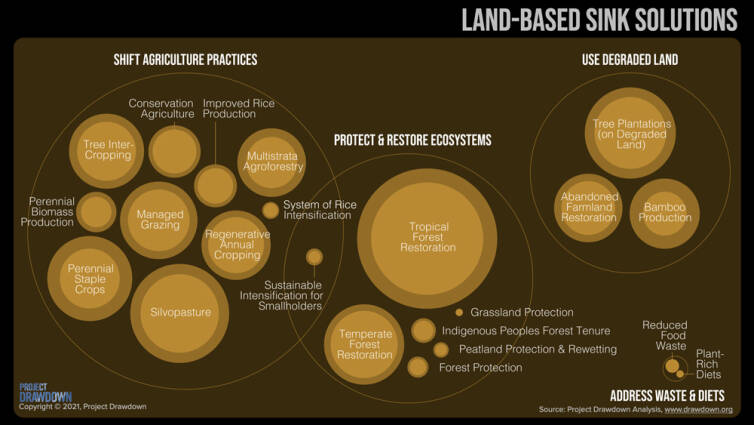
What’s Drawdown Learn doing to help food professionals tackle the challenges they’re facing?
“One of our next steps is going to focus on storytelling. People need to see these solutions in action. Not everyone can relate to the raw numbers and hard science. We want to connect with the people making these things happen. We’re going to do a deep dive into communities here in the US, listening to underserved and minority voices. Talking to not just executive directors but to the people on the ground implementing these solutions. I could tell you all day long about the impactful climate solutions we’ve looked at, but until you can put a face to them, until there are people in your neighborhood actually willing to step up, those are just words on a page. We don’t need more of those right now. The younger generation is rightfully angry at the state of climate solutions. They want their jobs to be meaningful, want to contribute to solving the problem. Every job is a climate job now.”
“We made a video series called Climate Solutions 101, in which we try to shift the narrative from the challenges towards the solutions. The series wasn’t initially aimed at food professionals, but it has resonated with people all over the world. For anyone wanting to build a solid foundation on climate solutions, the series is a great first step.
Staying focused on solutions becomes easier when you have a framework to put them in. Our framework consists of the ‘three S’es’ of reducing heat trapping gasses: reduce Sources, support Sinks, and improve Society. Just having that framework helps people make sense of what seems like an incomprehensible problem.”

Elizabeth Bagley wants to focus on climate solutions, instead of climate problems
“There’s a couple of different directions we could go in. Climate solutions 102 might be a deeper dive into different solution clusters. We might look at food, agriculture and land use and go much deeper than the cursory look we took in 101. We want to present these solutions visually, in a way that drives people to actions they can take in their own community. If we level up a little more and move to climate solutions 201, we are kind of moving from giving people the ingredients for a dish, to providing them with the recipe. We need to get into the kitchen and start cooking and baking alongside people so that the climate solution ingredients can turn into a dish that’s greater than the sum of its parts. We would go deeper into things like goals. What’s the difference between net zero and carbon negative, and why do we care? We would look at timeframes, like what would the different waves of climate action look like for all the different sectors? And how would we scale? All these solutions are like pieces on a chess board. How do we win this game of chess?”
What would climate solutions 102 look like?
What’s the first thing food producers need to know about how to solve the climate crisis?
“Reducing food waste. We need to be much more thoughtful and efficient about how food is produced to eliminate waste. There’s more wasted than just food. It’s land, labor, fertilizer, and all of those come with their greenhouse gas emissions. The way to tackle food waste really depends on where you are in the value chain. You can look at what for example ReFed is doing, or the work being done together with indiginous farmers to deindustrialize agriculture. There aren’t any fancy or flashy solutions, but we don’t need those. We have all the solutions we need to reach Drawdown, the point at which the amount of heat trapping gasses in our atmosphere begins to decrease. Some of the solutions for the food system are ancient techniques like silvopasture, which is something we abandoned because it couldn’t be efficiently industrialized.”

Elizabeth Bagley is the Director of Drawdown Learn at Project Drawdown. Food Inspiration spoke with her about focusing on climate solutions instead of climate problems, and the role food producers can and need to play to realize a livable future.
Jelle Steenbergen Xiao Er Kong

28 min



